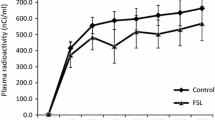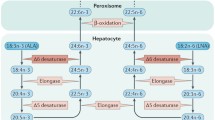Abstract
Rationale
Several drugs used to treat bipolar disorder (lithium and carbamazepine), when administered chronically to rats, reduce the turnover of arachidonic acid, but not docosahexaenoic acid, in brain phospholipids by decreasing the activity of an arachidonic acid-selective phospholipase A2. Although chronic valproic acid produces similar effects on brain arachidonic acid and docosahexaenoic acid turnover, it does not alter phospholipase A2 activity, suggesting that it targets a different enzyme in the turnover pathway.
Materials and methods/Results
By isolating rat brain microsomal long-chain fatty acyl–CoA synthetases (Acsl), we show in vitro that valproic acid is a non-competitive inhibitor of Acsl, as it reduces the maximal velocity of the reaction without changing the affinity of the substrate for the enzyme. While valproic acid inhibited the synthesis of arachidonoyl–CoA, palmitoyl–CoA, and docosahexaenoyl–CoA, the K i for inhibition of arachidonoyl–CoA synthesis (14.1 mM) was approximately one fifth the K i for inhibiting palmitoyl–CoA (85.4 mM) and docosahexaenoyl–CoA (78.2 mM) synthesis. As chronic administration of valproic acid in bipolar disorder achieves whole-brain levels of 1.0 to 1.5 mM, inhibition of arachidonoyl–CoA formation can occur at brain concentrations that are therapeutically relevant to this disease. Furthermore, brain microsomal Acsl did not produce valproyl–CoA.
Conclusions
This study shows that valproic acid acts as a non-competitive inhibitor of brain microsomal Acsl, and that inhibition is substrate-selective. The study supports the hypothesis that valproic acid acts in bipolar disorder by reducing the brain arachidonic acid cascade, by inhibiting arachidonoyl–CoA formation.




Similar content being viewed by others
References
Abbott FS, Acheampong AA (1988) Quantitative structure–anticonvulsant activity relationships of valproic acid, related carboxylic acids and tetrazoles. Neuropharmacology 27:287–294
Aly MI, Abdel-Latif AA (1980) Studies on distribution and metabolism of valproate in rat brain, liver, and kidney. Neurochem Res 5:1231–1242
Bazinet R, Weis MT, Rapoport SI, Rosenberger TA (2005a) Valproic acid inhibits brain microsomal long chain fatty acyl–CoA synthetases at therapeutically relevant concentrations. Exp Biol, p 3672 (Abstract)
Bazinet RP, Rao J, Chang L, Rapoport SI, Lee HJ (2005b) Chronic carbamazepine decreases the incorporation rate and turnover of arachidonic acid but not docosahexaenoic acid in brain phospholipids of the unanesthetized rat: relevance to bipolar disorder. Biol Psychiatry (in press)
Bazinet RP, Rao JS, Chang L, Rapoport SI, Lee HJ (2005c) Chronic valproate does not alter the kinetics of docosahexaenoic acid within brain phospholipids of the unanesthetized rat. Psychopharmacology (Berl) 182:180–185
Becker CM, Harris RA (1983) Influence of valproic acid on hepatic carbohydrate and lipid metabolism. Arch Biochem Biophys 223:381–392
Bolanos JP, Medina JM (1997) Effect of valproate on the metabolism of the central nervous system. Life Sci 60:1933–1942
Bosetti F, Weerasinghe GR, Rosenberger TA, Rapoport SI (2003) Valproic acid down-regulates the conversion of arachidonic acid to eicosanoids via cyclooxygenase-1 and -2 in rat brain. J Neurochem 85:690–696
Bradford MM (1976) A rapid and sensitive method for the quantitation of microgram quantities of protein utilizing the principle of protein-dye binding. Anal Biochem 72:248–254
Calabrese JR, Bowden C, Woyshville MJ (1995) Lithium and the anticonvulsants in the treatment of bipolar disorder. In: Kupfer D (ed) Psychopharmacology: the fourth generation of progress. Raven, New York, pp 1099–1111
Chang MC, Grange E, Rabin O, Bell JM, Allen DD, Rapoport SI (1996) Lithium decreases turnover of arachidonate in several brain phospholipids. Neurosci Lett 220:171–174
Chang MC, Bell JM, Purdon AD, Chikhale EG, Grange E (1999) Dynamics of docosahexaenoic acid metabolism in the central nervous system: lack of effect of chronic lithium treatment. Neurochem Res 24:399–406
Chang MC, Contreras MA, Rosenberger TA, Rintala JJ, Bell JM, Rapoport SI (2001) Chronic valproate treatment decreases the in vivo turnover of arachidonic acid in brain phospholipids: a possible common effect of mood stabilizers. J Neurochem 77:796–803
Cullingford TE, Dolphin CT, Sato H (2002) The peroxisome proliferator-activated receptor alpha-selective activator ciprofibrate upregulates expression of genes encoding fatty acid oxidation and ketogenesis enzymes in rat brain. Neuropharmacology 42:724–730
Deutsch J, Rapoport SI, Rosenberger TA (2003) Valproyl–CoA and esterified valproate are not found in brains of rats treated with valproic acid, but the brain concentrations of CoA and acetyl–CoA are altered. Neurochem Res 28:861–866
Fowler DW, Eadie MJ, Dickinson RG (1989) Transplacental transfer and biotransformation studies of valproic acid and its glucuronide(s) in the perfused human placenta. J Pharmacol Exp Ther 249:318–323
Friel P (1990) Valproyl CoA: an active metabolite of valproate? Med Hypotheses 31:31–32
Ghelardoni S, Tomita YA, Bell JM, Rapoport SI, Bosetti F (2004) Chronic carbamazepine selectively downregulates cytosolic phospholipase A2 expression and cyclooxygenase activity in rat brain. Biol Psychiatry 56:248–254
Green P, Gispan-Herman I, Yadid G (2005) Increased arachidonic acid concentration in the brain of Flinders Sensitive Line rats, an animal model of depression. J Lipid Res (in press)
Harris WE, Stahl WL (1983) Incorporation of cis-parinaric acid, a fluorescent fatty acid, into synaptosomal phospholipids by an acyl–CoA acyltransferase. Biochim Biophys Acta 736:79–91
Jacobsen FM (1993) Low-dose valproate: a new treatment for cyclothymia, mild rapid cycling disorders, and premenstrual syndrome. J Clin Psychiatry 54:229–234
Johannessen CU (2000) Mechanisms of action of valproate: a commentary. Neurochem Int 37:103–110
Lands WEM, Crawford GC (1975) Enzymes of membrane phospholipid metabolism. In: Martonosi A (ed) Enzymes of biological membranes, Plenum, New York, pp 3–85
Laposata M, Reich EL, Majerus PW (1985) Arachidonoyl–CoA synthetase. Separation from nonspecific acyl–CoA synthetase and distribution in various cells and tissues. J Biol Chem 260:11016–11020
Lee H, Rao J, Chang L, Rapoport S, Bazinet R (2004) The effects of chronic carbamazepine, an antibipolar disorder drug, on the turnover of arachidonic and docosahexaenoic acids in brain phospholipids of the awake rat. The Society for Neuroscience, San Diego, CA
Loscher W (1985) Valproic acid. In: Frey HH, Janz D (eds) Antiepileptic drugs. Handbook of experimental pharmacology, vol 74. Springer, Berlin Heidelberg New York, pp 507–537
Loscher W (1993) Effects of the antiepileptic drug valproate on metabolism and function of inhibitory and excitatory amino acids in the brain. Neurochem Res 18:485–502
Loscher W, Fisher JE, Nau H, Honack D (1989) Valproic acid in amygdala-kindled rats: alterations in anticonvulsant efficacy, adverse effects and drug and metabolite levels in various brain regions during chronic treatment. J Pharmacol Exp Ther 250:1067–1078
Mashek DG, Bornfeldt KE, Coleman RA, Berger J, Bernlohr DA, Black P, DiRusso CC, Farber SA, Guo W, Hashimoto N, Khodiyar V, Kuypers FA, Maltais LJ, Nebert DW, Renieri A, Schaffer JE, Stahl A, Watkins PA, Vasiliou V, Yamamoto TT (2004) Revised nomenclature for the mammalian long-chain acyl–CoA synthetase gene family. J Lipid Res 45:1958–1961
Meunier H, Carraz G, Neunier Y, Eymard P, Aimard M (1963) Pharmacodynamic properties of N-dipropylacetic acid. Therapie 18:435–438
Pope HG Jr, McElroy SL, Keck PE Jr, Hudson JI (1991) Valproate in the treatment of acute mania. A placebo-controlled study. Arch Gen Psychiatry 48:2–8
Rapoport SI, Chang MC, Spector AA (2001) Delivery and turnover of plasma-derived essential PUFAs in mammalian brain. J Lipid Res 42:678–685
Rintala J, Seemann R, Chandrasekaran K, Rosenberger TA, Chang L, Contreras MA, Rapoport SI, Chang MC (1999) 85 kDa cytosolic phospholipase A2 is a target for chronic lithium in rat brain. Neuroreport 10:3887–3890
Robinson PJ, Noronha J, DeGeorge JJ, Freed LM, Nariai T, Rapoport SI (1992) A quantitative method for measuring regional in vivo fatty-acid incorporation into and turnover within brain phospholipids: review and critical analysis. Brain Res Brain Res Rev 17:187–214
Saunders C, Voigt JM, Weis MT (1996) Evidence for a single non-arachidonic acid-specific fatty acyl–CoA synthetase in heart which is regulated by Mg2+. Biochem J 313 (Pt 3):849–853
Segel IR (1975) Enzyme kinetics: behavior and analysis of rapid equilibrium and steady-state enzyme systems. Wiley, New York
Setnik B, Nobrega JN (2004) Long-chain acyl–CoenzymeA synthetase-2 mRNA: increased cerebral cortex expression in an animal model of depression. Prog Neuropsychopharmacol Biol Psychiatry 28:577–582
Siafaka-Kapadai A, Patiris M, Bowden C, Javors M (1998) Incorporation of [3H]valproic acid into lipids in GT1-7 neurons. Biochem Pharmacol 56:207–212
Silva MF, Ruiter JP, IJlst L, Allers P, ten Brink HJ, Jakobs C, Duran M, Tavares de Almeida I, Wanders RJ (2001) Synthesis and intramitochondrial levels of valproyl–coenzyme A metabolites. Anal Biochem 290:60–67
Uberti MA, Pierce J, Weis MT (2003) Molecular characterization of a rabbit long-chain fatty acyl CoA synthetase that is highly expressed in the vascular endothelium. Biochim Biophys Acta 1645:193–204
Van Horn CG, Caviglia JM, Li LO, Wang S, Granger DA, Coleman RA (2005) Characterization of recombinant long-chain rat acyl–CoA synthetase isoforms 3 and 6: identification of a novel variant of isoform 6. Biochemistry 44:1635–1642
Watkins PA (1997) Fatty acid activation. Prog Lipid Res 36:55–83
Weis MT, Bercute A (1997) Comparison of long-chain fatty acyl–CoA synthetases from rabbit heart and liver: substrate preferences and effects of Mg2+. Biochem J 322(Pt 2):649–654
Williams RS, Cheng L, Mudge AW, Harwood AJ (2002) A common mechanism of action for three mood-stabilizing drugs. Nature 417:292–295
Wilson DB, Prescott SM, Majerus PW (1982) Discovery of an arachidonoyl coenzyme A synthetase in human platelets. J Biol Chem 257:3510–3515
Yamashita A, Sugiura T, Waku K (1997) Acyltransferases and transacylases involved in fatty acid remodeling of phospholipids and metabolism of bioactive lipids in mammalian cells. J Biochem (Tokyo) 122:1–16
Author information
Authors and Affiliations
Corresponding author
Rights and permissions
About this article
Cite this article
Bazinet, R.P., Weis, M.T., Rapoport, S.I. et al. Valproic acid selectively inhibits conversion of arachidonic acid to arachidonoyl–CoA by brain microsomal long-chain fatty acyl–CoA synthetases: relevance to bipolar disorder. Psychopharmacology 184, 122–129 (2006). https://doi.org/10.1007/s00213-005-0272-4
Received:
Accepted:
Published:
Issue Date:
DOI: https://doi.org/10.1007/s00213-005-0272-4




